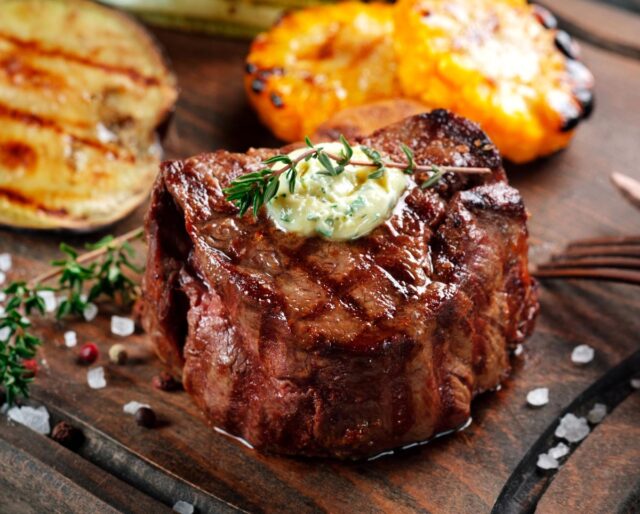by Susan Fleming

What should you look for when picking out a steak? Grain fed? Angus? Select? Marbling? Bright red?
I am sure you have seen the Select, Choice, and Prime labels on beef at the store, and you have also seen Certified Angus, Sterling Silver and maybe a few others. In addition, you may have noticed that there’s organic, hormone-free, free-range, etc. and undoubtedly, all of these choices have made it difficult for you and most other shoppers to figure out how to buy good beef.
And to make matters even more confusing, the USDA used to have three main categories in the beef grading system: Prime, Choice, and Good. But in 1976, that grading system changed. Reflecting America’s squeamishness at the sight of even the slightest bit of fat on a steak, the beef industry itself brought about even more grading system changes in the 1980s by shifting its marketing focus toward “leaner” beef. As a result, the Good category was renamed Select. At the time, that change seemed fairly subtle, but the quality of our beef has been irrevocably become inferior ever since.
“Good” was changed to “Select” for the purpose of marketing to health conscience Americans who would only accept very lean beef, and the beef industry began feeding cattle differently in order to produce that kind of leaner beef.
About 80 percent of our highest quality meat (highly marbled) is exported to Japan, because of our attitude toward the unsightly presence of fat on our steaks. Often, we inadvertently confuse the definitions of “healthful” vs. “quality”.
The major difference between Prime, Choice, Select, and standard is the degree of marbling (intramuscular fat) in the beef. And Prime’s cost continues to rise resulting in some high-end steak houses giving it up completely; they instead turn to Certified Angus, one of many “branded beef” programs that sell premium USDA Choice under a trade name.
The Certified Angus Beef Program began in 1978 in response to the 1976 lowering of USDA standards for Choice and Prime beef grades. Only about 18 percent of eligible, Angus, Angus-crossbred, or other Native cattle meet the 8 requirements of the CAB which are: High Marbling, Youthful Maturity, Leanness, Superior Muscling, No Neck Hump, No Internal Hemorrhages, and No Dark Coloring.
Characteristics of good, quality, flavorful beef:
- Corn-fed
- At least 1” in thickness
- Good breed: including but not limited to: Angus, Black Angus, Hereford, Limousin, Longhorn, Wagyu, Shorthorn, Highland; you want to avoid dairy cows such as Guernsey and Jersey.
- Look for a store or butcher who has steaks from one of the following programs: 1855, Harris Ranch Farms of California, or Mishima Ranch (Natural Wagyu) Kobe.
- Good marbling (higher marbling gives better flavor, but does not affect the tenderness) that is in long lines of fat rather than chunks.
- Aged by either the dry or wet process:
Dry aging: beef is hung in a refrigerated cooler, at a specific temperature and humidity, for 10 to 28 days after harvest and prior to cutting; the moisture evaporates from the meat, creating an extremely tender texture and a concentrated flavor. The old-style steak houses routinely dry aged all their beef, but now only a very select few still employ this expensive nearly-lost art form, and even today, only the highly priced loin and rib cuts are aged because of the cost of the refrigerated storage.
Wet aging: beef is vacuum-sealed in plastic bags within 24 hours. Often, beef reaches the grocery store within 2 to 4 days after harvest. Most restaurants sell wet-aged meat with the advent of vacuum packaging and efficiencies in beef processing and transportation; wet aging is a much less expensive process than dry aging.
Best steaks for grilling:
T-bone, New York Strip, Fillet Mignon, Ribeye.
***********************************************************************
Perfectly Grilled Steaks
4 1 1/4-to-1 1/2-inch-thick boneless rib-eye or
New York strip steaks (about 12 ounces each)
or filets mignons (8 to 10 ounces each),
trimmed
2 tablespoons canola oil
Kosher salt and freshly ground pepper
4 tablespoons unsalted butter
About 30 minutes before grilling, remove the steaks from the refrigerator and let sit, covered, at room temperature. Heat your grill to high. Brush the steaks on both sides with oil and season liberally with salt and pepper. Place the steaks on the grill and cook until golden brown, 4 to 5 minutes. Turn the steaks over and continue to grill 3 to 5 minutes for medium-rare (an internal temperature of 135 degrees F), 5 to 7 minutes for medium (140 degrees F) or 8 to 10 minutes for medium-well (150 degrees F). Transfer the steaks to a cutting board or platter, place 1 tablespoon of butter on each steak, tent loosely with foil and let rest 5 minutes before slicing.
Susan Fleming is a local home economist and food columnist. You can check out her blog at www.tastefultales.com

